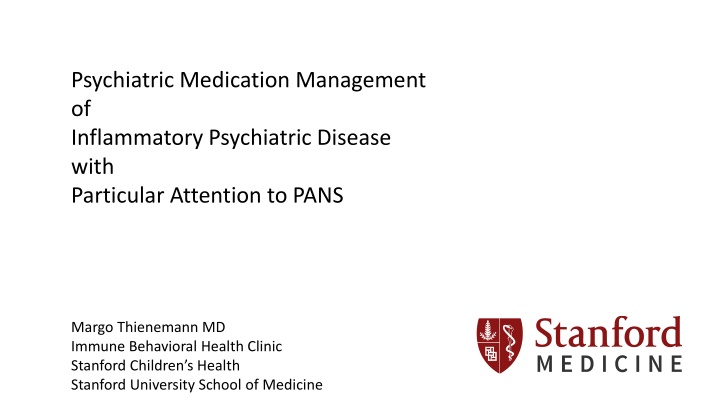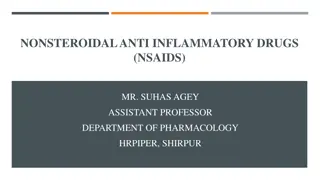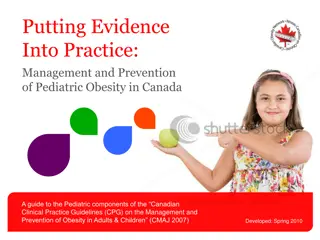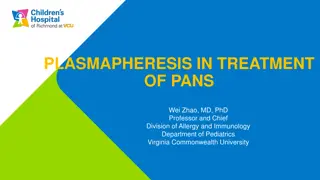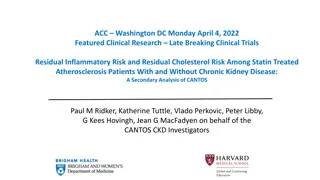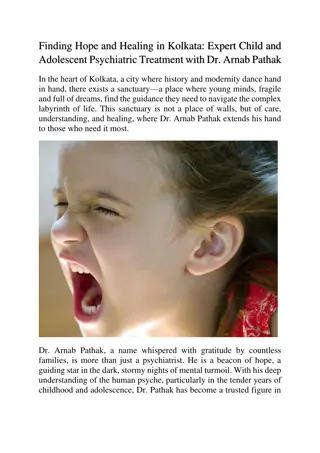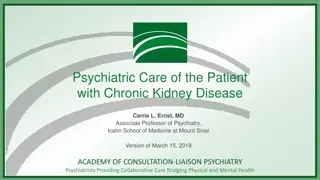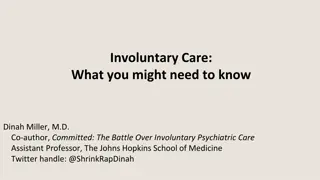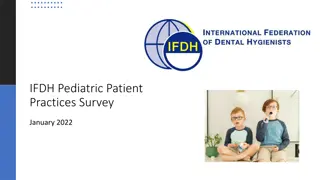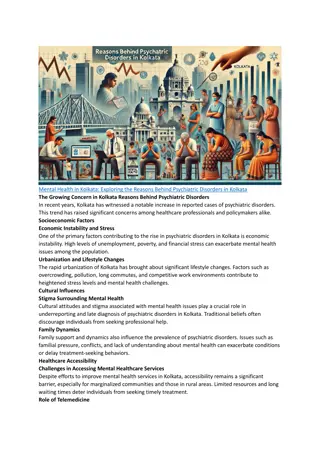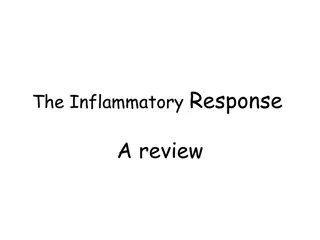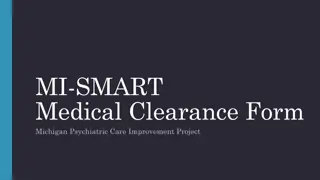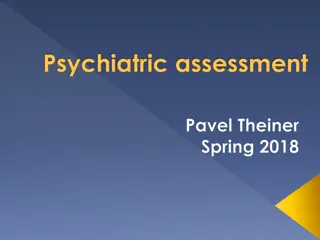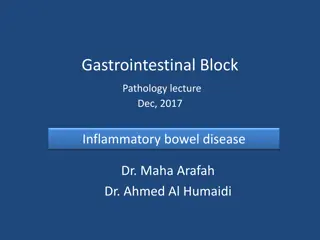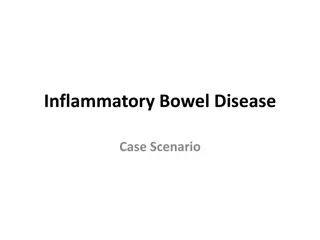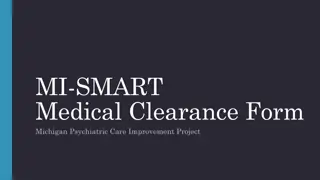Management of Inflammatory Psychiatric Disease with Focus on PANS in Pediatric Patient
Dr. Margo Thienemann discusses the psychiatric medication management of a 10-year-old boy with inflammatory psychiatric disease, particularly focusing on Pediatric Acute-onset Neuropsychiatric Syndrome (PANS). The patient presented with various symptoms including compulsions, mood swings, OCD, oppositional behavior, and suicidal intent. The case involved multiple hospitalizations and treatment trials with medications like quetiapine and sertraline. The patient showed resistance to psychotherapy and displayed severe obsessive and impulsive behaviors. Subsequent evaluation revealed a range of symptoms, including cognitive difficulties, anxiety, depression, sensory sensitivities, and motor issues. The treatment plan included interventions such as Azithromycin, Naproxen, and family evaluation for strep.
Download Presentation

Please find below an Image/Link to download the presentation.
The content on the website is provided AS IS for your information and personal use only. It may not be sold, licensed, or shared on other websites without obtaining consent from the author.If you encounter any issues during the download, it is possible that the publisher has removed the file from their server.
You are allowed to download the files provided on this website for personal or commercial use, subject to the condition that they are used lawfully. All files are the property of their respective owners.
The content on the website is provided AS IS for your information and personal use only. It may not be sold, licensed, or shared on other websites without obtaining consent from the author.
E N D
Presentation Transcript
Psychiatric Medication Management of Inflammatory Psychiatric Disease with Particular Attention to PANS Margo Thienemann MD Immune Behavioral Health Clinic Stanford Children s Health Stanford University School of Medicine
Case: 10-year-old boy Chief Complaint: Parents : He is unrecognizable. Patient : I am happy to be suicidal. Compulsions: touching, drinking from only certain glasses Hit his own larynx Scratched his face Repeatedly ran away, including barefoot, causing injury
HPI November: Ear infection, mycoplasma pneumonia January: Head injury skiing: Post-concussive symptoms February: Sudden state change manifesting as suicidal intent Ran away from home at night, hid from parents and police. Poker face and blank stare Mood swings Oppositional behavior OCD Handwriting terrible No illness: Group A Strep not assessed Hospitalized psychiatrically X 4 d Dx d depression, anxiety, PTSD, post-concussion syndrome. Rx d quetiapine 6mg 150mg; no improvement Rx d sertraline 6.25 12.5mg, regression
HPI (cont.) March: University Inpatient Unit hospitalization x 1 month -Sx Severely obsessive Ego-syntonic suicidal thoughts; life is suffering Psychomotor restlessness Frequent head banging Catastrophic thinking Resisted psychotherapy: brainwashing -Dx: MRI normal Neuropsychiatric evaluation: no significant functional deficits -Rx: Beta-blocker Escitalopram: 2.5 mg 20 mg Started clawing himself, banging his head, was hyperactive
April: Initial Presentation PANS Clinic: ROS OCD: Contamination, arranging, knitting, would only wear one outfit, 2-hour bedtime ritual. TICS: Verbal Tics IMPULSIVITY: Worsened; cannot wait for anything RESTRICTED EATING: wanted to starve. CONCENTRATION: Worsened SEPARATION ANXIETY: Slept with parent. Refused school COGNITIVE: READING : Refused as was too difficult OTHER ANXIETY: Phobias: spiders, water/swimming in murky water, heights, roller coasters MEMORY: Worsened DEPRESSION: Anhedonia and SI SENSORY: Light and sound sensitive. Vestibular issues MANIA: Marked productivity, spending money, grandiose SLEEP: Initial insomnia, nightmares about falling RAGE ATTACKS: Running away required 24 h hired highly skilled aide URINARY: New nocturia Enuresis x 1. FATIGUE AGITATION: Since accident/concussion, threatened to kill people, self, excessive motor activity INFECTION: Itchy rash on his thighs, buttocks. On Azithromycin MOTOR: Handwriting changes, clumsiness INFLAMMATION: On Azithromycin
Course of Illness/Treatment Pediatric/Medical Continue Azithromycin (helpful) Rx Naproxen (NSAID) Evaluate family members for strep Per Psychiatry: Decrease escitalopram to 17.25mg/day to address behavioral activation, suicidality, agitation, nightmares Activation improved with decrease, but pace was limited by withdrawal symptoms. Underwent extremely slow taper 20 to 10 over 2 years! In-Home CBT Parent therapy Behavior management Address family accommodation to OCD (felt hamstrung by patient s report of SI)
What is the role of mental health treatment in PANS and other inflammatory brain disorders ? Mental Health Providers Role Psychoeducation Coordination with other parts of the treatment team Environmental interventions (safety, schools) Behavioral strategies (behavior modification techniques, minimize accommodation) Psychotherapies Evidence-supported therapies for other symptoms (eg CBT for OCD) Pharmacotherapy Screen/treat for medical PTSD
Using Psychopharmacology in Inflammatory Brain Disorders/PANS When Acutely, perhaps, to facilitate cooperation with evaluation and treatment Acutely, perhaps, to decrease suffering and improve function Before, with, or after immunomodulation for - Delirium (antipsychotics) - Catatonia (lorazepam) - Steroid side-effects (antipsychotics) Later, for residual psychiatric symptoms How Other interventions can also be essential at same time Treating infection Treating inflammation Illness natural, changing course is an additional variable Try to change only one treatment variable at a time
PANS Patients Treated with Psychiatric Medications Can Do Very Poorly A number of children were hospitalized for agitation, behavioral dyscontrol, suicidality, and mood lability when when their symptoms failed to respond to higher and higher doses of antidepressants and antipsychotics as used in conventional, evidence-based psychopharmacotherapy. We have seen children and adolescents who have been treated with the medications, sent to residential treatment because of lack of response and worsening due to escalating dosing of standard pharmacotherapies.
Psychiatric Medications for Psychiatric Symptoms Alpha adrenergic agents (clonidine, guanfacine) Antidepressants/Serotonin Reuptake Inhibitors (SSRI s) Antihistamines Antipsychotics Anti-seizure medications (gabapentin, etc) Benzodiazepines Beta-blockers Mood stabilizers (lithium. etc) Other (amantadine) Other (melatonin, zolpidem Agitation Anxiety Catatonia Cognitive disturbances Delirium Eating restriction Mood disturbances OCD Psychotic symptoms Sleep disturbance Steroid side-effects Tics
Psychiatric Medications Psychiatric Symptoms Alpha adrenergic agents (clonidine, guanfacine) Antidepressants/Serotonin Reuptake Inhibitors (SSRI s) Antihistamines Antipsychotics Anti-seizure medications (gabapentin, etc) Benzodiazepines Beta-blockers Mood stabilizers (lithium. etc) Other (amantadine) Other (melatonin, zolpidem Agitation Anxiety Catatonia Cognitive disturbances Delirium Eating restriction Mood disturbances OCD Psychotic symptoms Sleep disturbance Steroid side-effects Tics
188 We Reviewed 263 Consecutive PANS Cases in the Stanford Immune Behavioral Health Clinic who had had Trials of Antipsychotics and/or Antidepressants Looking at Side Effects and Doses. 2012-2017 263 Patients with abrupt early-onset OCD due to PANS tolerate lower doses of antidepressants and antipsychotics. Thienemann M, Park M, Chan A, Frankovich J. J Psychiatr Res. Mar 2021
Most common antidepressant side effects in our sample Behavioral activation anxiety (15%) agitation (12%) akathisia or restlessness (12%) aggression (9%) Suicidality (7% ) lower than what has been seen in PANS patients in general (30-40 % in reported samples) we prescribe using low starting doses
Antidepressant Dose Tolerability: Fluoxetine Equivalents 20 mg 12 mg 6 mg Low starting dose AACAP guidelines after Black Box warning inserted
Most common side effects in our sample Antipsychotics dystonia (16%) weight gain (9%) sedation (9%) non-specific movement abnormalities (10%) anxiety (9%)
Antipsychotic Tolerability: Risperidone equivalents. < half of target dose for other childhood indications Antipsychotic Tolerability 1.3 mg Schizophrenia, Bipolar Mood, Tourette 1.5 mg 0.7 mg
Findings: Doses of Antidepressants and Antipsychotics Tolerated doses and doses at which side effects were noted were lower than or equal to the typical recommended starting doses and treatment doses for each medication used. For most patients (76%) who developed side effects, there existed an antidepressant or antipsychotic dose that could be tolerated without side effects or toxicity sometime during the course of treatment. The severity of brain inflammation may impact the likelihood of side effects. can have initial poor tolerability of antipsychotics but then benefit from them after receiving immunotherapy (Kuppuswamy et al., 2014). My opinion: Our review did not separate out flare/remission status at time of medication trial. Our analyses likely combined data from patients in flares and remissions (medications used to treat residual symptoms) If medications are better tolerated when patients are in remission, as clinical experience suggests, then the doses that were not tolerated during flares were likely even lower that our data indicates.
Limitations Limitations Design: retrospective chart review Some patients came to us already on medications Did not assess flare state/flare markers at time of medication trial Did not assess P450 metabolizer status Did not have formal SE assessment measure Did not have blood levels Strengths First and largest venture into this inquiry Wanted to get our clinical experience quantified and disseminated quickly as we saw so many difficulties in our patients and patients who had been treated before we met them
Antidepressants (and Antipsychotics) can cause behavioral activation. Behavioral activation symptoms resemble target PANS symptoms! irritability agitation anxiety panic depression suicidality restlessness hostility aggression insomnia disinhibition emotional lability impulsivity hypomania/mania paranoia and other psychotic symptoms sleep disturbance
Behavioral Activation Most antidepressant side effects are related to behavioral activation ( agitation, aggression, self-injury) mood disturbance (mania, anger) Typically starts early in treatment (within the first 3 months) with dosage increases abates with antidepressant discontinuation or dosage lowering Hypothesized mechanisms increased mood instability sensitivity to increased serotonergic tone
Side Effect Monitoring: Using these medications in general, in inflammatory brain disorders Assess baseline symptoms mimicking signs of activation from SSRIs before rx impulsivity restlessness agitation irritability Insomnia distractibility Watch for Acute and worsening anxiety Induction of hypomania or mania Suicidality: SSRIs carry a black box warning Behavioral activation or serotonin syndrome. Explain to parents that higher and quicker doses challenges that children with inflammatory brain disorders tend to have more serious side effects. Warn families to ask a pharmacist or their provider about potential risk of combining SSRIs with other medications or herbal supplements prior to taking them.
TEASAP Treatment-Emergent Activation and Suicidality Assessment Profile 38 item questionnaire Queries: Irritability Akathisia, hyperkinesis and somatic anxiety Mania Self-injury, suicidality and harm to others Psychometric properties of the Treatment-Emergent Activation and Suicidality Assessment Profile (TEASAP) in youth with OCD. Bussing R, Murphy TK, Storch EA, McNamara JP, Reid AM, Garvan, CW, Goodman WK Psychiatry Res. 2013 Feb 28;205(3):253-61
Why might antidepressants and antipsychotics tolerated at lower doses in our PANS population than might be expected? Developmental factors/age Serotonin and dopamine receptors change with age Genetically determined Cytochrome P450 enzyme metabolism differences metabolizer subtypes eliminate drug with different efficiencies inflammation may down-regulate P450 enzyme activity Inflammation affecting Blood Brain Barrier (BBB) keeps most drugs out of the central nervous system reported to be dysfunctional in inflammatory brain diseases BBB compromise may affect the amount of drug delivered to the brain in patients with PANS.
Why might children and adolescents with PANS tolerate only lower doses of medication? Brain inflammation from other causes has been seen with poor antipsychotic tolerability, with resultant agitation and aggression. Acute infectious encephalitis: HIV or other viral NMDAR encephalitis 47% treated with neuroleptics experienced Neuroleptic Malignant Syndrome Bickerstaff (autoimmune) brainstem encephalitis Identified neuronal receptor antibodies target the same receptors as psychotropic drugs Dopamine D1 and D2, and serotonin 5-HT2A and 5- HT2C antibodies found GAS-infected PANDAS-model rodents Dopamine levels/dopamine release affected by altered Ca2+/calmodulin-dependent protein kinase II enzyme (CaMK II) signaling that affects found in rodents exposed to GAS antigen and human PANDAS patients Anti-CNS striatal cholinergic antibodies found in sera of children with PANDAS
Antipsychotics in other Inflammatory Brain Disorders: similar to PANS Despite the risk of side effects at higher doses, antipsychotics [at the right (low) doses] may still be helpful for treating agitation, aggression, psychotic symptoms, tics, and OCD in other brain inflammatory disorders including Lupus NMDAR encephalitis Hashimoto's encephalitis.
Psychotropics may improve inflammation?!! Fluoxetine, paroxetine, and sertraline reduced inflammation by affecting cytokines and BBB integrity in mouse models of Parkinson's, ischemic stroke, brain injury, and spinal cord injury SSRI treatment was found to be associated with decreased levels of pro-inflammatory markers in adults with major depression and in another study with generalized anxiety disorder One immunocompromised child with chronic enterovirus encephalitis who failed immunotherapy improved only when treated with fluoxetine Fluoxetine inhibits microglial activation and decreases microglial cytokine production Ongoing trials of fluoxetine and fluvoxamine in COVID. The antipsychotic, risperidone has been found neuroprotective in rats, as have olanzapine and aripiprazole in cultured human immune cell lines
We have observed that in our clinical practice of starting out at low doses (roughly of suggested starting doses) and slowly titrating upward, mindful of other concomitant treatments and inflammatory state. We rarely begin treatment with antipsychotics or antidepressants, other than for prn use, before addressing infection and inflammation. We use psychopharmacology in concert with other psychotherapies: Psychoeducation Behavioral modification Evidence supported psychotherapies for individual symptom clusters, such as CBT, CBIT/HRT Parent PTSD group treatment Though we have focused here on intolerable side effects from these psychotropic medications, they may be helpful and tolerated. It is worth investigating how those medications, properly dosed, might positively affect inflammation.
Psychiatric Symptoms Standard Psychiatric Treatments Agitation Anxiety Catatonia Cognitive disturbances Eating restriction Mood disturbances OCD Psychotic symptoms Sleep disturbance Tics Alpha adrenergic agents (clonidine, guanfacine) Antidepressants/Serotonin Reuptake Inhibitors (SSRI s) Antihistamines Antipsychotics Anti-seizure medications (gabapentin, etc) Benzodiazepines Beta-blockers Mood stabilizers (Lithium)
Psychiatric Symptoms Standard Psychiatric Treatments Agitation Anxiety Acute Anxiety Persistent Catatonia Cognitive disturbances Mood disturbances OCD Psychotic symptoms Sleep disturbance Tics Alpha adrenergic agents (clonidine, guanfacine) Antidepressants/Serotonin Reuptake Inhibitors (SSRI ) Antihistamines Antipsychotics Anti-seizure medications (gabapentin, etc) Benzodiazepines Beta-blockers Mood stabilizers (lithium, anti-sz meds) Other (amantadine) Dexmedetomidine (by Anesthesia Service)
Psychiatric Symptoms Standard Psychiatric Treatments Agitation Anxiety acute Anxiety persistent Catatonia Cognitive disturbances Mood disturbances OCD Psychotic symptoms Sleep disturbance Tics Alpha adrenergic agents (clonidine, guanfacine) Antidepressants/Serotonin Reuptake Inhibitors (SSRI s) Antipsychotics Anti-seizure medications (gabapentin, etc) Benzodiazepines Beta-blockers Mood stabilizers (Lithium)
Psychiatric Symptoms Standard Psychiatric Treatments Agitation Anxiety Catatonia Cognitive disturbances Eating restriction Mood disturbances OCD Psychotic symptoms Sleep disturbance Tics Alpha adrenergic agents (clonidine, guanfacine) Antidepressants/Serotonin Reuptake Inhibitors (SSRI s) Antipsychotics Anti-seizure medications (gabapentin, etc) Benzodiazepines Beta-blockers Mood stabilizers (Lithium) Other (amantadine, zolpidem)
What are the psychiatric symptoms? What are the standard psychiatric treatments? Agitation Anxiety Catatonia Cognitive disturbances Mood disturbances OCD Psychotic symptoms Sleep disturbance Tics Alpha adrenergic agents (clonidine, guanfacine) Antidepressants/Serotonin Reuptake Inhibitors (SSRI s) Antipsychotics Anti-seizure medications (gabapentin, etc) Benzodiazepines Beta-blockers Mood stabilizers (Lithium) Other (amantadine) Stimulant medication
Psychiatric Symptoms Standard Psychiatric Treatments Agitation Anxiety Catatonia Cognitive disturbances Food restriction Mood disturbances OCD Psychotic symptoms Sleep disturbance Tics Alpha adrenergic agents (clonidine, guanfacine) Antidepressants/Serotonin Reuptake Inhibitors (SSRI ) Antihistamines (hydroxyzine) Antipsychotics Anti-seizure medications (gabapentin, etc) Benzodiazepines Beta-blockers Mood stabilizers (Lithium) Other (amantadine) Stimulant medication
Psychiatric Symptoms Standard Psychiatric Treatments Agitation Anxiety Catatonia Cognitive disturbances Mood disturbances OCD Psychotic symptoms Sleep disturbance Tics Alpha adrenergic agents (clonidine, guanfacine) Antidepressants/Serotonin Reuptake Inhibitors (SSRI s) Antipsychotics Anti-seizure medications (gabapentin, lamotrigine, etc) Benzodiazepines Beta-blockers Mood stabilizers (Lithium) Other (amantadine, zolpidem)
Psychiatric Symptoms Standard Psychiatric Treatments Agitation Anxiety Catatonia Cognitive disturbances Mood disturbances OCD Psychotic symptoms Sleep disturbance Tics Alpha adrenergic agents (clonidine, guanfacine) Antidepressants/Serotonin Reuptake Inhibitors (SSRI s) Antipsychotics Anti-seizure medications (gabapentin, etc) Benzodiazepines Beta-blockers Mood stabilizers (Lithium) N-acetyl cysteine Other (amantadine, zolpidem)
Psychiatric Symptoms Standard Psychiatric Treatments Agitation Anxiety Catatonia Cognitive disturbances Eating restriction Mood disturbances OCD Psychotic symptoms Sleep disturbance Tics Alpha adrenergic agents (clonidine, guanfacine) Antidepressants/Serotonin Reuptake Inhibitors (SSRI s) Antipsychotics Anti-seizure medications (gabapentin, etc) Benzodiazepines Beta-blockers Mood stabilizers (Lithium) Other (amantadine, zolpidem)
What are the psychiatric symptoms? What are the standard psychiatric treatments? Agitation Anxiety Catatonia Cognitive disturbances Eating restrictions Mood disturbances OCD Psychotic symptoms Sleep disturbance Tics Alpha adrenergic agents (clonidine, guanfacine) Antidepressants/Serotonin Reuptake Inhibitors (SSRI s) Antihistamines Antipsychotics Anti-seizure medications (gabapentin, etc) Benzodiazepines Beta-blockers Mood stabilizers (Lithium) Other (amantadine, zolpidem) Other (melatonin)
What are the psychiatric symptoms? What are the standard psychiatric medication treatments? Agitation Anxiety Catatonia Cognitive disturbances Eating restriction Mood disturbances OCD Psychotic symptoms Sleep disturbance Tics Alpha adrenergic agents (clonidine, guanfacine) Antidepressants/Serotonin Reuptake Inhibitors (SSRI s) Antipsychotics Anti-seizure medications (gabapentin, etc) Benzodiazepines Beta-blockers Mood stabilizers (Lithium) Other (amantadine, zolpidem)
References References A. Alam, N.V. Puri Inefficacy of antipsychotics in treatment of delirium and agitation in two cases of Bickerstaff brainstem encephalitis J. Neuropsychiatry Clin. Neurosci., 26 (2014), pp. 176-178, 10.1176/appi.neuropsych.13040078 W. Breitbart, R. Marotta, M.M. Platt, H. Weisman, M. Derevenco, C. Grau, K. Corbera, S. Raymond, S. Lund, P. Jacobsen A double-blind trial of haloperidol, chlorpromazine, and lorazepam in the treatment of delirium in hospitalized AIDS patients Am. J. Psychiatr., 153 (1996), pp. 231-237, 10.1176/ajp.153.2.231 L. Brimberg, I. Benhar, A. Mascaro-Blanco, K. Alvarez, D. Lotan, C. Winter, J. Klein, A.E. Moses, F.E. Somnier, J.F. Leckman, S.E. Swedo, M.W. Cunningham, D. Joel Behavioral, pharmacological, and immunological abnormalities after streptococcal exposure: a novel rat model of sydenham chorea and related neuropsychiatric disorders Neuropsychopharmacology, 37 (2012), pp. 2076-2087, 10.1038/npp.2012.56 R. Bussing, T.K. Murphy, E.A. Storch, J.P.H. McNamara, A.M. Reid, C.W. Garvan, W.K. Goodman Psychometric properties of the treatment-emergent activation and suicidality assessment profile (TEASAP) in youth with OCD Psychiatr. Res., 205 (2013), pp. 253-261, 10.1016/j.psychres.2012.09.019 R. Cabezas, M. vila, J. Gonzalez, R.S. El-Bach , E. B ez, L.M. Garc a-Segura, J.C.J. Coronel, F. Capani, G.P. Cardona-Gomez, G.E. Barreto Astrocytic modulation of blood brain barrier: perspectives on Parkinson's disease Front. Cell. Neurosci., 4 (2014), p. 211, 10.3389/fncel.2014.00211 N. Carrey, S. Kutcher Developmental pharmacodynamics: implications for child and adolescent psychopharmacology J. Psychiatry Neurosci., 23 (1998), pp. 274-276
E.S. Chung, Y.C. Chung, E. Bok, H.H. Baik, E.S. Park, J.Y. Park, S.H. Yoon, B.K. Jin Fluoxetine prevents LPS-induced degeneration of nigral dopaminergic neurons by inhibiting microglia-mediated oxidative stress Brain Res., 1363 (2010), pp. 143-150,10.1016/j.brainres.2010.09.049 M.W. Cunningham, C.J. Cox Autoimmunity against dopamine receptors in neuropsychiatric and movement disorders: a review of Sydenham chorea and beyond Acta Physiol. (2016),10.1111/apha.12614 M.P. DelBello, R. Goldman, D. Phillips, L. Deng, J. Cucchiaro, A. Loebel Efficacy and safety of lurasidone in children and adolescents with bipolar I depression: a double-blind, placebo-controlled study J. Am. Acad. Child Adolesc. Psychiatry, 56 (2017), pp. 1015-1025,10.1016/j.jaac.2017.10.006 L.R. Frick, M. Rapanelli, K. Jindachomthong, P. Grant, J.F. Leckman, S. Swedo, K. Williams, C. Pittenger Differential binding of antibodies in PANDAS patients to cholinergic interneurons in the striatum Brain Behav. Immun., 69 (2018), pp. 304-311,10.1016/j.bbi.2017.12.004 A. Gaedigk, K. Sangkuhl, M. Whirl-Carrillo, T. Klein, J. Steven Leeder Prediction of CYP2D6 phenotype from genotype across world populations Genet. Med., 19(2017), pp. 69-76, 10.1038/gim.2016.80 B. Garcia-Delgar, A. Morer, E. Varela, S. Romero, M. Garc a, B.J. Coffey, L. L zaro Activation in children and adolescents treated with selective serotonin reuptake inhibitors: a weighty reason J. Clin. Psychopharmacol., 38 (2018), pp. 475-480,10.1097/JCP.0000000000000923 D.A. Geller, S.L. Hoog, J.H. Heiligenstein, R.K. Ricardi, R. Tamura, S. Kluszynski, J.G. Jacobson Fluoxetine treatment for obsessive-compulsive disorder in children and adolescents: a placebo-controlled clinical trial J. Am. Acad. Child Adolesc. Psychiatry, 40 (2001), pp. 773-779,10.1097/00004583-200107000-00011 J. Gofshteyn, A.M. C rdenas, D. Bearden Treatment of chronic enterovirus encephalitis with fluoxetine in a patient with X-linked agammaglobulinemia Pediatr. Neurol., 64(2016), pp. 94-98, 10.1016/j.pediatrneurol.2016.06.014 T.A. Hammad, T. Laughren, J. Racoosin Suicidality in pediatric patients treated with antidepressant drugs Arch. Gen. Psychiatr., 63(2006), pp. 332-339,10.1001/archpsyc.63.3.332
J. Hannestad Comment on paroxetine prevents loss of nigrostriatal dopaminergic neurons by inhibiting brain inflammation and oxidative stress in an experimental model of Parkinson's disease J. Immunol., 185(2010), p. 4966,10.4049/jimmunol.1090095 Y. Hayasaka, M. Purgato, L.R. Magni, Y. Ogawa, N. Takeshima, A. Cipriani, C. Barbui, S. Leucht, T.A. Furukawa Dose equivalents of antidepressants: evidence-based recommendations from randomized controlled trials J. Affect. Disord., 180(2015), pp. 179-184,10.1016/j.jad.2015.03.021 R. Hou, G. Ye, Y. Liu, X. Chen, M. Pan, F. Zhu, J. Fu, T. Fu, Q. Liu, Z. Gao, D.S. Baldwin, Z. Tang Effects of SSRIs on peripheral inflammatory cytokines in patients with Generalized Anxiety Disorder Brain Behav. Immun., 81 (2019), pp. 105-110,10.1016/j.bbi.2019.06.001 C.A. Kirvan, S.E. Swedo, D. Kurahara, M.W. Cunningham Streptococcal mimicry and antibody-mediated cell signaling in the pathogenesis of Sydenham's chorea Autoimmunity, 39 (2006), pp. 21-29,10.1080/08916930500484757 A. Kumar, M.T. Williams, H.T. Chugani Evaluation of basal ganglia and thalamic inflammation in children with pediatric autoimmune neuropsychiatric disorders associated with streptococcal infection and tourette syndrome: a positron emission tomographic (PET) study using 11C-[R]-PK11195 J. Child Neurol., 30(2015), pp. 749-756,10.1177/0883073814543303 P.S. Kuppuswamy, C.R. Takala, C.L. Sola Management of psychiatric symptoms in anti-NMDAR encephalitis: a case series, literature review and future directions Gen. Hosp. Psychiatr., 36 (2014), pp. 388-391,10.1016/j.genhosppsych.2014.02.010
F.Y.Liu, J. Cai, C. Wang, W.Ruan, G.P.Guan, H.Z. Pan, J.R. Li, C.Qian, J. Chen, L. Sen Wang, G. Chen Fluoxetine attenuates neuroinflammation in early brain injury after subarachnoid hemorrhage: a possible role for the regulation of TLR4/MyD88/NF- B signaling pathway J. Neuroinflammation, 15(2018), p. 347,10.1186/s12974-018-1388-x D. Lotan, I. Benhar, K. Alvarez, A. Mascaro-Blanco, L. Brimberg, D. Frenkel, M.W.Cunningham, D. Joel Behavioral and neural effects of intra-striatal infusion of anti-streptococcal antibodies in rats Brain Behav. Immun., 38(2014), pp. 249-262,10.1016/j.bbi.2014.02.009 M.J. Luft, M. Lamy, M.P. DelBello, R.K. McNamara, J.R. Strawn Antidepressant-Induced activation in children and adolescents: risk, recognition and management Curr. Probl. Pediatr. Adolesc. Health Care, 48(2018), pp. 50-62,10.1016/j.cppeds.2017.12.001 K.S.MacDowell, B. Garc a-Bueno, J.L.M. Madrigal, M. Parellada, C.Arango, J.A. Mic , J.C.Leza Risperidone normalizes increased inflammatory parameters and restores anti-inflammatory pathways in a model of neuroinflammation Int. J. Neuropsychopharmacol., 16(2013), pp. 121-135,10.1017/S1461145711001775 L. Minjon, E. van den Ban, E.de Jong, P.C.Souverein, T.C.G.Egberts, E.R. Heerdink Reported adverse drug reactions in children and adolescents treated with antipsychotics J. Child Adolesc. Psychopharmacol., 29(2019), pp. 124-132,10.1089/cap.2018.0139 S.S.Mohammad, H. Jones, M. Hong, M. Nosadini, C. Sharpe, S.C.Pillai, F.Brilot, R.C. Dale Symptomatic treatment of children with anti-NMDAR encephalitis Dev. Med. Child Neurol., 58(2016), pp. 376-384,10.1111/dmcn.12882 T.K.Murphy, A. Segarra, E.A.Storch, W.K.Goodman SSRI adverse events: how to monitor and manage Int. Rev. Psychiatr., 20(2008), pp. 203-208,10.1080/09540260801889211
T.K. Murphy, E.A. Storch, M.S. Strawser Selective serotonin reuptake inhibitor-induced behavioral activation in the PANDAS subtype Prim. Psychiatr., 13 (2006), pp. 87-89 E. Offidani, G.A.Fava, E. Tomba, R.J. Baldessarini Excessive mood elevation and behavioral activation with antidepressant treatment of juvenile depressive and anxiety disorders: a systematic review Psychother. Psychosom., 82 (2013), pp. 132-141, 10.1159/000345316 W.A. Ray, C.M. Stein, K.T. Murray, D.C. Fuchs, S.W. Patrick, J. Daugherty, K. Hall, W.O. Cooper Association of antipsychotic treatment with risk of unexpected death among children and youths JAMA Psychiatr., 76 (2019), pp. 162-171, 10.1001/jamapsychiatry.2018.3421 A.M. Reid, J.P.H. McNamara, T.K. Murphy, A.G. Guzick, E.A. Storch, G.R.Geffken, R. Bussing Side-effects of SSRIs disrupt multimodal treatment for pediatric OCD in a randomized-controlled trial J. Psychiatr. Res., 71 (2015), pp. 140-147, 10.1016/j.jpsychires.2015.10.006 S.P. Reinblatt, S. Dosreis, J.T. Walkup, M.A. Riddle Activation adverse events induced by the selective serotonin reuptake inhibitor fluvoxamine in children and adolescents J. Child Adolesc. Psychopharmacol., 19 (2009), pp. 119-126, 10.1089/cap.2008.040 D.J. Safer, J.M. Zito Treatment-emergent adverse events from selective serotonin reuptake inhibitors by age group: children versus adolescents J. Child Adolesc. Psychopharmacol., 16 (2006), pp. 159-169, 10.1089/cap.2006.16.159 L.T. Schumacher, A.P. Mann, J.G.MacKenzie Agitation management in pediatric males with anti-N-Methyl-D-Aspartate receptor encephalitis J. Child Adolesc. Psychopharmacol., 26 (2016), pp. 939-943, 10.1089/cap.2016.0102 R.R.Shah, R.L. Smith Inflammation-induced phenoconversion of polymorphic drug metabolizing enzymes: hypothesis with implications for personalized medicine Drug Metab. Dispos., 43 (2015), pp. 400-410, 10.1124/dmd.114.061093 C. Shimasak, R.E. Frye, R. Trifiletti, M. Cooperstock, G. Kaplan, I. Melamed, R. Greenberg, A. Katz, E. Fier, D. Kem, D. Traver, T. Dempsey, E. Latimer, A. Cross, J.P. Dunn, R. Bentley, K. Alvarez, S. Reim, J. Appleman Evaluation of the Cunningham PanelTMin pediatric autoimmune neuropsychiatric disorder associated with streptococcal infection (PANDAS) and pediatric acute-onset neuropsychiatric syndrome (PANS): changes in antineuronal antibody titers parallel changes in J. Neuroimmunol., 339 (2020), p. 577138, 10.1016/j.jneuroim.2019.577138 H.V. Solomon, K.W. Cates, K.J. Li Does obtaining CYP2D6 and CYP2C19 pharmacogenetic testing predict antidepressant response or adverse drug reactions? Psychiatr. Res., 271 (2019), pp. 604-613, 10.1016/j.psychres.2018.12.053 B. Stapel, I. Sieve, C.S. Falk, S. Bleich, D. Hilfiker-Kleiner, K.G. Kahl Second generation atypical antipsychotics olanzapine and aripiprazole reduce expression and secretion of inflammatory cytokines in human immune cells J. Psychiatr. Res., 105 (2018), pp. 95-102, 10.1016/j.jpsychires.2018.08.017
J.R. Strawn, J.A. Welge, A.M. Wehry, B. Keeshin, M.A. Rynn Efficacy and tolerability of antidepressants in pediatric anxiety disorders: a systematic review and meta-analysis Depress. Anxiety, 32(2015), pp. 149-157,10.1002/da.22329 A. Varatharaj,I. Galea The blood-brain barrier in systemic inflammation Brain Behav. Immun., 60 (2017), pp. 1-12, 10.1016/j.bbi.2016.03.010 L. Wang, R. Wang, L. Liu, D. Qiao, D.S. Baldwin, R. Hou Effects of SSRIs on peripheral inflammatory markers in patients with major depressive disorder: a systematic review and meta-analysis Brain Behav. Immun., 79 (2019), pp. 24-38, 10.1016/j.bbi.2019.02.021 A.M. Wehry, L. Ramsey, S.E. Dulemba, S.A. Mossman, J.R. Strawn Pharmacogenomic testing in child and adolescent psychiatry: an evidence-based review Curr. Probl. Pediatr. Adolesc. Health Care, 48 (2018), pp. 40-49,10.1016/j.cppeds.2017.12.003 T.E. Wilens, J. Biederman, A. Kwon, R. Chase, L. Greenberg, E. Mick, T.J. Spencer A systematic chart review of the nature of psychiatric adverse events in children and adolescents treated with selective serotonin reuptake inhibitors J. Child Adolesc. Psychopharmacol., 13 (2003), pp. 143-152,10.1089/104454603322163862 S.W. Woods Chlorpromazine equivalent doses for the newer atypical antipsychotics J. Clin. Psychiatr., 64(2003), pp. 663-667,10.4088/JCP.v64n0607 J. Xu, R.-J. Liu, S. Fahey, L. Frick, J. Leckman, F. Vaccarino, R. Duman, K. Williams, S. Swedo, C. Pittenger Antibodies from children with PANDAS bind specifically to striatal cholinergic interneurons and alter their activity Am. J. Psychiatr. (2020), 10.1176/appi.ajp.2020.19070698 . Yekta , A.E. Tufan Prescribing trends of atypical antipsychotic drugs in an outpatient unit of a child and adolescent clinic in Turkey Clin. Neuropharmacol., 41(2018), pp. 23-27, 10.1097/WNF.0000000000000263 J. Zheng, J. Frankovich, E. McKenna, N. Rowe, S. MacEachern, N. Ng, L. Tam, P. Moon, J. Gao, M. Thienemann, N. Forkert, K. Yeom Association of pediatric acute-onset neuropsychiatric syndrome with microstructural differences in the deep grey matter JAMA Netw. Open, 3 (2020), Article e204063,10.1001/jamanetworkopen.2020.4063
